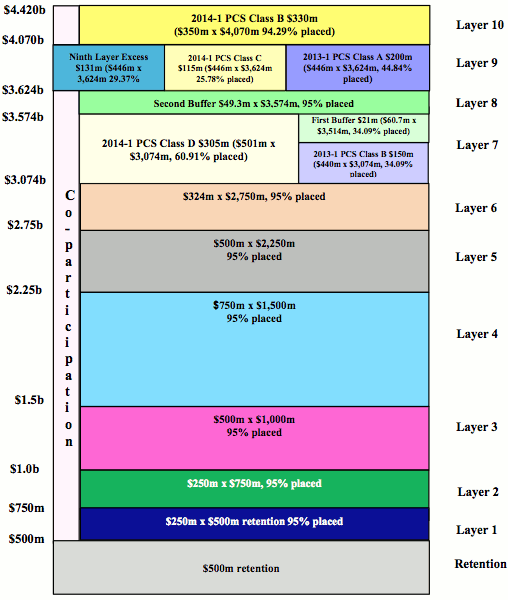U.S. primary insurance group Allstate successfully turned to the traditional reinsurance market to purchase 7-year coverage that it failed to secure from the capital markets with its recently dropped Sanders Re 2015-1 catastrophe bond.
Allstate tested the boundaries of the cat bond market with its most recent attempted issuance. The proposed $130m Sanders Re Ltd. (Series 2015-1) saw Allstate looking for 7 year reinsurance protection for losses from multiple U.S. perils.
It was the first cat bond with a duration of seven years, stretching the boundaries of what insurance-linked securities (ILS) investors were prepared to allocate capital to.
In the end, the cat bond never completed, after investors failed to show interest within the price guidance that the deal was marketed with. That led to the order book for Sanders Re 2015-1 building outside of guidance and as a result Allstate walked away and turned to the reinsurance market instead.
In Allstate’s first-quarter results disclosures yesterday the insurer revealed its nationwide per-occurrence reinsurance programme for the year ahead, with a new 7 year layer seemingly slotting into the tower where the Sanders Re 2015-1 cat bond would likely have been.
What would have been Sanders 2015-1 is now named layer nine of the nationwide catastrophe reinsurance programme tower, providing $131m of limit through a 29.37% participation in a layer that covers $446m excess $3.624 billion of losses to Allstate.
That layer sits directly alongside catastrophe bond coverage from the Sanders Re Ltd. (Series 2013-1) Class A tranche and the Sanders Re Ltd. (Series 2014-1) Class B tranche of notes.
Also noteworthy is the fact that Allstate has secured another layer of its programme on a 7 year basis. The sixth layer of its programme provides $324m of limit (95% placed) above an attachment of $2.75 billion of losses.
The catastrophe reinsurance programme that Allstate revealed today covers its personal property and auto lines of business. The Florida tower is currently being placed during the second quarter, in readiness for hurricane season.
Allstate’s reinsurance programme has the goal of having “no more than a 1% likelihood of exceeding average annual aggregate catastrophe losses by $2 billion, net of reinsurance, from hurricanes and earthquakes, based on modeling assumptions and applications currently available.”
These two layers, six and nine, were placed in the traditional reinsurance market with comparable terms to layers one through five, according to Allstate. Both of these layers have 7 year terms and also offer Allstate one reinstatement of limits during the period of cover.
Interesting layers six and nine also have a variable reset feature, allowing the coverage to be flexed a little annually within pre-defined boundaries. This is perhaps an example of catastrophe bond best practice being applied in the traditional reinsurance world, as cat bonds have developed these flexible features to allow sponsors to adjust the coverage during the longer terms.
So Allstate successfully got the coverage it was looking for with the proposed Sanders Re 2015-1 catastrophe bond by turning to the traditional reinsurance market. A 7 year cover is long by anyone’s reckoning, but clearly the traditional reinsurance market came down to the pricing expectation that Allstate had.
It seems likely that the insurance-linked securities (ILS) market would have supported the transaction had the pricing been a little higher. Reports suggested that the book for Sanders Re 2015-1 was building, just a little above the top end of guidance.
Some might suggest that the ILS market and its investors have missed out here, by losing this deal to the traditional reinsurance market. ILS investors would likely respond by saying that they felt the pricing was too keen.
The fact that ILS investors continue to push-back on deal’s where the pricing or terms are felt too aggressive is good for the market. With issuance of cat bonds still rising it is important not to accept risks where the pricing could be considered too low.
For Allstate the 7 year cover provides more certainty in terms of reinsurance premiums paid and reduces volatility. That could be extremely valuable to the insurer should catastrophe losses tick upwards, resulting in any price corrections in the market.
The structure of Allstate’s nationwide catastrophe reinsurance program, including these 7 year layers (numbered 6 and 9), can be seen below:
 View all of our Artemis Live video interviews and subscribe to our podcast.
View all of our Artemis Live video interviews and subscribe to our podcast.
All of our Artemis Live insurance-linked securities (ILS), catastrophe bonds and reinsurance video content and video interviews can be accessed online.
Our Artemis Live podcast can be subscribed to using the typical podcast services providers, including Apple, Google, Spotify and more.

Allstate's 2015 Nationwide Per Occurrence Excess Catastrophe Reinsurance Program































